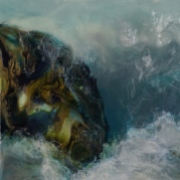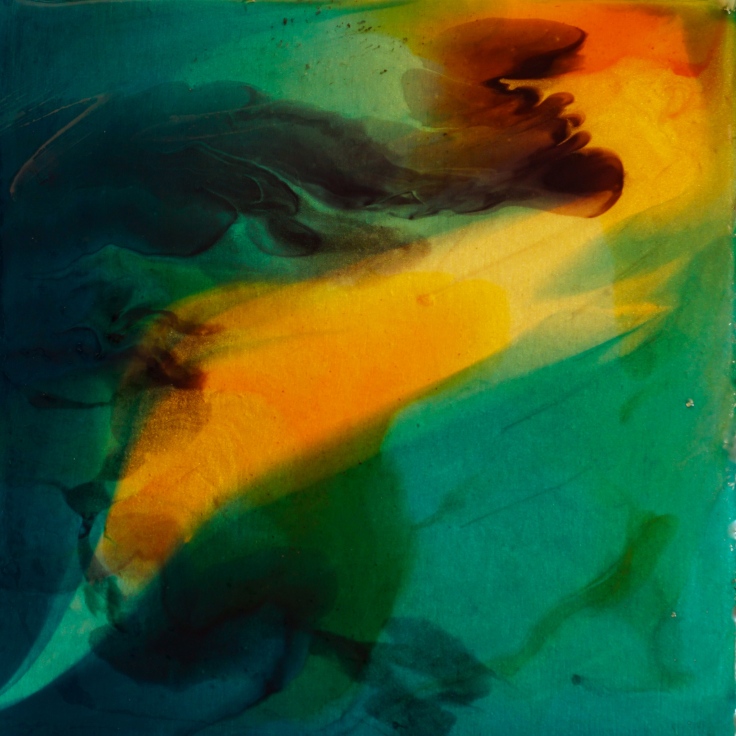Above Works are from Surfacing, an Artist’s Journey
I’ve been working on this solo show for a long time, and am happy to say that it’s now hanging at the Gallery at Glendeven Inn & Lodge, Mendocino now through May 15, 2019.
Happy, and relieved. Creating a meaningful show that hangs together well is sort of like giving birth. Less painful, but anxiety-provoking. I was ready to be done with anxiousness. And then another atmospheric river hit the West Coast.
By the time we packed up for the trip, they were evacuating Guerneville and Monte Rio, beloved little towns on the Russian River, and strange weather was creating havoc all over Northern California. Crazy amounts of rain. Both Highways to the Coast off of northern 101 were closed due to flooding. I am told that this is not unusual for Highway 128 when the Navarro is full and the tide is high, but they were turning people away even at Highway 20, a more northerly route we rarely take but that has always been an alternate. One of my Mendocino friends said that the day we were traveling up, the winding road through Comptche that is always the back route for locals had been plagued with mudslides and trees falling from the sodden hills. She said, and I quote, “you’d be crazy to drive up here today”.
Geez. That was enough for me. I love Mendocino, but I must say I am not fond of these highways where the winding rarely ends, even in good weather. After almost 7 months of living there and coming back to Livermore at least once a month, I can drive them without whiteknuckling it all the way, but give me a threat of a tree landing on us with the Explorer loaded with 21 paintings representing over four years of dedicated experimentation, study and intense work and the personal safety of my partner and me and, well…
My partner, Duane, is so understanding and a great travel companion. The radio didn’t help, and neither did the Maps app on my iPhone. Weturned around and then turned back north first on the rain drenched Freeway 80 Berkeley and started to head home again after Santa Rosa. Then, I checked the weather again for the next day and it looked like it might really clear up – and he looked at me and said, hey, we are so close, let’s head up to Cloverdale and get a motel room and try again tomorrow.
We did, and the rain and even the fog suspended over 128 began to clear by 8:30 am the next morning. The drive was beautiful, as it always is – oak woodlands, lovely Anderson Valley, the ethereal redwoods, and finally the sea – but disconcerting, still. Small mudslides, too many to count. Lots of standing water, some flowing over the roads still, streams pushed to their limits, mostly small downed trees chainsawed in half and tossed to the side of the road (Nancy Puder, a good friend that has lived in the area since the 70’s, tells me that locals drive these roads with chainsaws in the back during periods of heavy rains).
Yes, we need the rain. Yes, I’m thankful this won’t be a drought year. It would be nice, though, if it would come down a bit more sporadically.
We got to lovely Glendeven early, in time to have coffee and biscotti in the Farmhouse and watch the sea rolling in to Van Damme Beach and the llamas kicking about and the chickens doing their chickeny things while gearing up to lay Glendeven’s free-range eggs. It was sunny and almost warm. When it was time to hang, Nancy Puder joined us and we put the show up in record time. Having capable Duane on my team is mandatory; having Nancy and her designer eye join in created one of those magical art hanging days where it all just seemed to work. Some people are just easy to hang with in more ways than one.
Oh yeah, about the show! Surfacing, An Artist’s Journey, explores the progression of the pour paintings up from underwater – the reef and coral pieces I painted previously – and exhibits the still-evolving coastal rock formations and the sea battering them which were my struggle and goal during my term as Artist in Residence 2017-18 at the Mendocino Art Center. There’s more to it than that; I’m working on a blog about how they evolved and what happened to me during that program (now that I finally understand it), but this is getting really long and I felt that the journey to actually just hang the show was part of gestating these works and the bringing them up for viewing was part of the journey’s story.
So. The coastal rocks are joined by several Underwater works in this exhibit. Standing in the middle of the gallery, it’s as if you feel the undulation of the movement of water, like you are in the Pacific but oddly not cold. Peaceful. At one with yourself and your evolutionary journey. Where you came from, where you are now, and where you are going become one.
That may be taking it too far. Sort of.
The paintings look great hung together. Yes, I said that. Those who know me personally know that while I’m not really a braggart (or at least I think I’m not, how does one know for sure?), I am far from humble – at least about painting. It’s a good show, if I do say so myself. Pour painting taken to a different level, all painted with a reverence for our ocean and copious amounts of that art explorer thing I think I might be addicted to that I find so fascinating with this medium.
Plus it’s just so cool to see them dry, go from milky to glasslike ahh-ness. I wish you could see that.
Or see the show. They are so much better in person.

About Glendeven Inn & Lodge
This place is beyond charming, a serene getaway in an amazing setting. They earn the accolades they’ve gotten from so many magazines with attention to detail and caring for their guests, so much so that they have been expanding and purchasing neighboring property to make the experience available to even more.
Even their website is fun to explore. They give each guest a packet of chickenfeed so that they can become acquainted with the hens that will lay their breakfast eggs! And, you can participate in llama feeding!!!
You won’t find much on the site about the gallery as they are starting a reboot of it, but they are part of the Mendocino Whale Festival – their weekend is March 8-10, and they’ve done a nice writeup of my exhibition here.
Woot woot!
















 When we Skyped to interview for this piece, D.O.M. was busy painting a masterful Madonna, whose eyes dare you to see her as anything but powerful. Madonna’s just gotta see this one.
When we Skyped to interview for this piece, D.O.M. was busy painting a masterful Madonna, whose eyes dare you to see her as anything but powerful. Madonna’s just gotta see this one.



Recent Comments